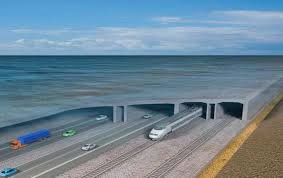A groundbreaking engineering project is underway beneath the Baltic Sea, where Denmark and Germany are constructing what will become the world’s longest immersed tunnel the “Fehmarnbelt Tunnel”. Spanning 18 kilometers, the tunnel aims to revolutionize travel across Europe by significantly reducing travel times and improving connectivity between Scandinavia and the rest of the continent.
This colossal infrastructure is not just a marvel of modern engineering but a game-changer for European transport. Once complete, the journey from Rødby in southern Denmark to Puttgarden in northern Germany will be slashed from 45 minutes by ferry to just 10 minutes by car or seven minutes by train. The tunnel will also reduce travel time between Copenhagen and Hamburg from five hours to two and a half, further tightening European integration.
Constructed using a unique method, the tunnel is made of 90 prefabricated sections, each approximately 217 meters long and 42 meters wide. These massive steel sections, weighing around 73,000 tons each, are being assembled at a dedicated 1,200-acre site in southeastern Denmark. From there, they will be towed to the seabed and precisely lowered into place using GPS and camera systems.

“This tunnel is unlike anything built before,” says Henrik Vincentsen, CEO of Fehmarn A/S, the state-owned Danish company behind the project. “No undersea tunnel has ever been constructed in this manner it’s truly a record-breaking feat.”
Initially, a bridge was considered, but strong winds and potential ship collisions made a tunnel the safer and more economical choice. “The seabed here is soft, so boring through it like in the Channel Tunnel wasn’t an option,” explains Professor Pierre Goltermann from the Technical University of Denmark. “An immersed tunnel was the best solution.”
Despite environmental concerns that delayed the project for years, construction began after a 2020 legal victory over opposition from environmental groups. These groups had argued that the area’s sensitive marine habitat home to rare fish and larvae — could be disrupted by the noise and construction activity. Vincentsen assures that “extensive measures” are being taken to reduce environmental impact.
Funded primarily by Denmark at a cost of around $8 billion (with additional support from the European Commission), the tunnel is expected to be operational by 2029. It will feature two rail tracks, two road lanes, and emergency access corridors. An estimated 12,000 vehicles and 100 trains are expected to pass through the tunnel daily, with toll revenues helping repay the borrowed construction funds.

The Fehmarnbelt Tunnel is not just a major transport project it’s also expected to stimulate economic growth in one of Denmark’s poorest regions. “This project has been long-awaited by the local community,” says project manager Anders. It’s expected to create thousands of jobs and boost regional tourism and commerce.
As Europe continues to invest in sustainable infrastructure, the Fehmarnbelt Tunnel stands as a testament to innovation, resilience, and regional cooperation.



